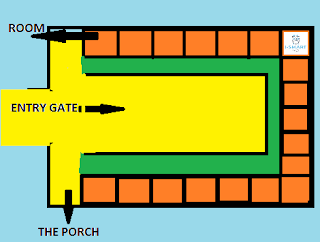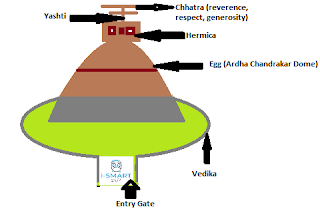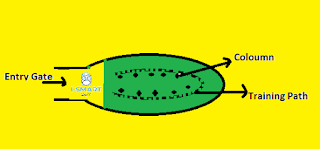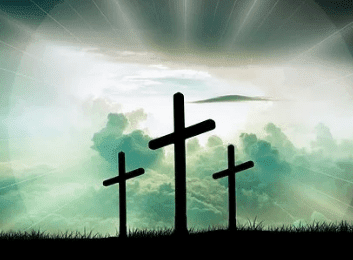I-Role:

A:-Architecture
Specialty:-
- Mostly bricks are made, some also use stones.
- Also influenced by religion, especially Buddhism [Pal dynasty ruler and Buddhist followers] and Hindu temples.
Evidence of Buddhist art:-
Major Monastery
|
Monastery
|
Builder
|
|
Odantpuri [Vihar Sharif (not currently relic)]
|
Gopal
|
|
Vikramashila (Most Important)
|
Dharmapala
|
|
Sompur (present-day Bangladesh)
|
No Information
|
Vikramshila Monastery: Most Discussed and Excellent among Pal Monastery.
Important structural features:
Entrance doors, open courtyards, various rooms, two stores,steps.In addition to all these monasteries, South East Asian Shailendra Vambhi ruler Balaputradev built a Buddhist vihara in Nalanda. Whose style is influenced by both native and foreign style elements.

The pre-existing Stupa construction tradition of Pal Kala also developed systematically.The structure of the stupas of Pala period can be understood in the following diagrams.The relics of Buddha and each of the signs are worshiped through this stupa.


B:-Sculpture

Sculpture has a notable place among the important features of the Pala period. Especially the bronze sculptures made at this time can be compared to the Chola bronze sculptures in South India at this time [contemporary of Pala dynasty]. The sculpture of the Pala period is mainly inspired by the sculptures of the Gupta period. Pal sculpture can be seen in two parts – 1-bronze sculptures 2-stone sculptures
1-Bronze Sculptures:-
Important features
- The most outstanding among Pal idols
- Molded
- Ornamented
Major scavengers:-
2-Stone Statues:
During the Pala period, various statues of basalt stone were made mainly with bronze statues. These pulpers were sourced from Munger, Santhal Parganas etc. Salient features of stone sculptures:-
- Depiction of the front body
- Ornamented
In addition to bronze and stone sculptures, there is evidence of forms of clay sculptures, pottery etc. in the forms related to Pala idol art. Which are used for decoration.
C:-Painting

1-Manuscript Illustration:-
- These types of illustrations are found mainly on copper plates.
- The purpose of making them was to expand and decorate the content.
- The use of colors like red, black, yellow, white, etc. is found mainly in these paintings.
- These types of paintings are considered to be in the category of miniatures, the main one being the picture called “Ashta Sahasrif Pragya Paramita” which is currently preserved in the library of Cambridge University “London”.
- Buddhist Tantric art is also believed to have an influence on this painting.
2-Wall or Wall printing: –
- Mural paintings or wall paintings are also notable in the Pala carpet paintings whose main features are :-Geometrically depicting humans, animals, flowers, etc.
- Later, the effect of such illustration can also be seen in the context of Madhubani painting.
- Typical examples of graffiti have been found from Saraitila (Nalanda).
II-Critical review and conclusion: –
It is clear from the above description that various forms of art developed during the Pala period. But Pala Kala was also criticized by art critics at some points, the major being the following: –
- In most forms of art, repetition is a defect, that is, duplication of existing elements and lack of newness.
- Under the sculpture, the sculptures of the Pala period are also built on the basis of the development of Mathura and Gandhara style in the post-Mauryan period and the sculptural style of the Gupta period.
- The painting is mostly an iteration of the developed painting in Ajanta (Maharashtra), Bagh Cave (Madhya Pradesh) painting.
- F is about special originality. In fact, due to the highly ornamentation of the idols, the effect of artificiality is more visible due to which the liveliness and naturalness are destroyed.
- It has also been criticized for marking only the façade of the statues.
- Despite all these criticisms, not only did the Pala rulers not only have a strong presence in the politics of pre-medieval India or else, in terms of development of sapatya art, sculpture, painting etc., Bihar’s glorious art, tradition also added new dimensions.


